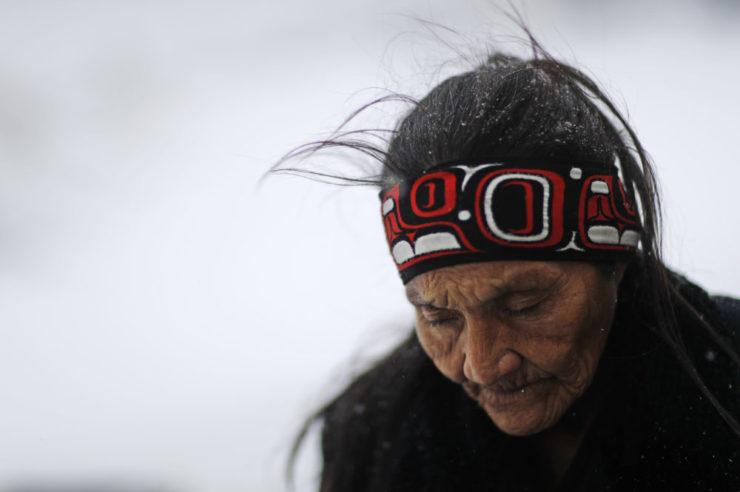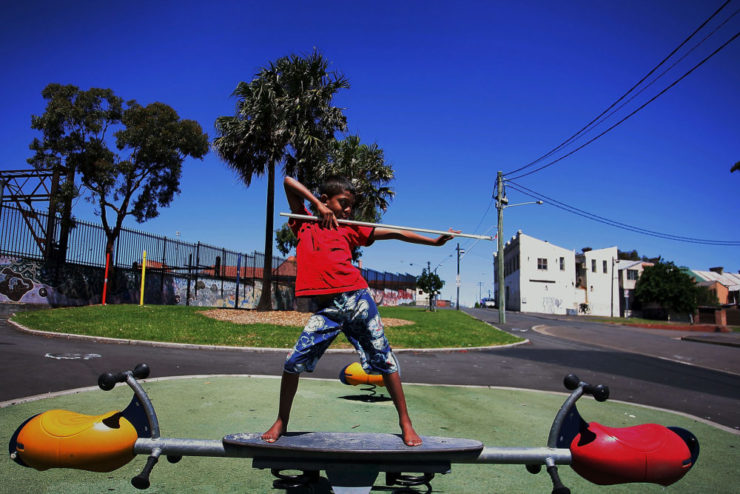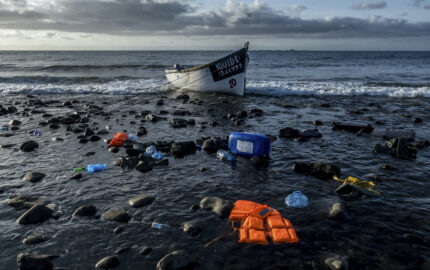Cree woman Connie Oakes said she was innocent of the murder of Casey Armstrong.
She said it when the police failed to produce fingerprints. She said it when they failed to produce DNA evidence. When the jury in the city of Medicine Hat, Alberta, where she and the victim lived, found her guilty, she said it again. And when the sole witness to the crime recanted her testimony, she said it one more time.
“The whole case was built on the shoulders of Wendy Scott, who had an IQ of 50 and admitted to lying to police,” says Jorge Barrera, an investigative reporter with Aboriginal Peoples Television Network (APTN) in Canada. “We seemed to be the only ones who cared about the case.”
During his investigation, Barrera learned that police fed information to Wendy Scott during interrogations while she was high. Barrera obtained court documents revealing the car police believed was used at the time of the murder, and he followed a trail of drugs and money to discover the vehicle had been sold to a drug dealer for crack and cash long before the killing took place. He meticulously chronicled each twist and turn in the case, from a judge’s ban on releasing Wendy Scott’s interrogation videos to retrial delays due to prosecutor’s handling of files. After nearly three years of dogged investigation, Barerra’s reporting helped secure Oakes’ release from prison.
Since Oakes’ release, officials have called for a public inquiry into how the police investigation was conducted. But apart from APTN’s ongoing coverage, the story has received little attention. “We covered it, we followed it, and thanks to the coverage, Connie was, in fact, set free,” says Jean La Rose, APTN’s Chief Executive Officer. “There was a brief mention of it on the public network in Canada, the CBC, but a very small mention and that’s it … In the case of Connie, it was of interest to us, but not very much to Canadians.”
Mainstream outlets resort to parachuting into indigenous communities, leading to a poverty-porn style of journalism
The struggle to bring indigenous stories to a wider audience isn’t new and isn’t uniquely Canadian. Coverage of indigenous affairs often remains limited to dying languages, cultural pageantry, disheartening living conditions, or troubling drug, alcohol or suicide statistics. In the United States, news outlets routinely ignore indigenous communities except when stories such as the Dakota Access Pipeline (DAPL) thrust Native people into the spotlight. In the case of DAPL, reporters often treated the incident as an isolated event despite the fact that the social, historical and legal environment that ignited protests in North Dakota are not unique to the Standing Rock Sioux Tribe. They are, in fact, shared across Indian Country by all tribes.
Yet in other parts of the world, media organizations are moving toward more substantive, representative coverage of indigenous issues. In the Nordic countries, indigenous Sámi news units primarily cover Sámi affairs in Finland, Sweden, and Norway and produce content for the countries’ public broadcasting networks. In Australia, BuzzFeed launched an aboriginal affairs beat in 2015 after high demand for indigenous content from young audiences.
One solution to covering communities that have been traditionally closed to outsiders and distrustful of media: Hire indigenous reporters. However, a more radical approach is for news organizations to make reporting in indigenous communities a priority—regardless of whether the reporters are indigenous themselves—and rethink old attitudes toward newsgathering in marginalized communities.
“I’ve always strongly felt that indigenous journalists telling indigenous stories is critically important,” says Duncan McCue, an Anishinaabe journalist with the Canadian Broadcasting Corporation (CBC) and creator of “Reporting in Indigenous Communities,” an online guide offering tips for non-Native journalists. “That said, I also believe that indigenous issues and indigenous communities are not communities that should be left solely to indigenous journalists. If we do that, if we simply play in our own sandbox, then we’re not speaking to the broader audience and we need to be.”
With more than 370 million indigenous people on the planet—nearly five percent of the global population—occupying almost 20 percent of the earth’s territory, insufficient to nonexistent coverage of their communities not only represents a missed opportunity, but a significant failure for an industry hoping to find voice and relevance in the 21st century.
According to the United Nations’ 2015 “State of the World’s Indigenous Peoples” report, poor living conditions, low employment rates, and insufficient access to food, water and health services have severe impacts on the health of indigenous communities, while climate change and environmental pollution pose serious threats to indigenous well-being. Mix those issues with geographic isolation, add discrimination, racism, and a lack of cultural understanding, and you have a recipe for one of the most marginalized groups in the world. Unsurprisingly, access to media is also a serious problem for indigenous groups, and a lack of educational opportunities for indigenous people can solidify existing inequality in newsrooms.
“If you’re going to cover Indian Country, cover it as a place and allow the stories to take you where they take you instead of coming with pre-conceived ideas,” says APTN’s Barrera, who is not indigenous. “Pretend you’re a foreign correspondent and you’re going to a different country and cover it like that.”

According to Barrera, the best way to think about Indian Country—a legal term with popular usage denoting areas with indigenous populations in the U.S and Canada—is to imagine it as an archipelago: Independent entities living in parallel with the country in which they exist. Each island has its own perspectives, histories, heroes, agendas, and desires. By focusing on Indian Country as a place, Barrera says journalists can avoid doing the occasional one-off special coverage series driven by an issue or a tragedy. Most often, mainstream outlets resort to parachuting into indigenous communities, leading to a poverty-porn style of journalism, while stories about sports, food, technology, education, healthcare, sex, fashion, art, or science rarely make the news despite being integral parts of indigenous life.
“Comparisons to reporting as a foreign correspondent are apt for most non-indigenous journalists,” says CBC’s McCue. “You wouldn’t simply throw a reporter from another country into the deep end of a foreign country and expect daily journalism when they’re operating on their own in difficult circumstances. A foreign correspondent needs to have support.” By treating Indian Country as a place, reporters like Barrera and McCue have been able to follow and engage with communities to advance stories in meaningful ways.
The lack of coverage by mainstream outlets played out when Canada finalized the Indian Residential Schools Settlement Agreement (IRSSA) in 2006. In the 1900s, tens of thousands of indigenous children were taken from their families and placed in the residential school system, a network of boarding schools created to forcibly assimilate Native children into Canadian culture. The settlement was the largest class action lawsuit in the nation’s history, creating a compensation package of about $2 billion for survivors. While the settlement made national headlines, only a few outlets continued reporting on IRSSA after the verdict.
“APTN, in following the story, started to realize that a lot of lawyers were, in fact, milking the survivors to the point that by the time the payment came in, they owed most of it to a lawyer,” APTN CEO La Rose says. “If you have a lawyer, who, by agreement settlement, was to charge no more than 10 percent of the total amount payable to the survivor who ends up pocketing 80 percent, it’s an illegal act.”
In the same way reporters cover any other beat, familiarity with the issues can pay off. In 2015, when millions of gallons of toxic water spilled out of the Gold King Mine in southern Colorado, turning the Animas River bright yellow, reporters from around the country were quick to cover the disaster. But as the sludge made its way south into the Navajo Nation, only a handful of news outlets followed.
“I think in the very beginning a lot of reporters were focused on the discoloration and sensationalizing the spill but weren’t really looking at how it impacted people,” says Antonia Gonzales, anchor and producer of National Native News (NNN). “Part of our coverage that was unique and different was exploring the Native angle and finding out how the tribes in the area were being impacted.”
Broadcast on over 200 public radio stations in the U.S., NNN serves as a headline news service, providing daily newscasts with indigenous stories from across the United States, Canada, and other parts of the world. Gonzales says the news is produced from a Native perspective, and her coverage of the Gold King Mine spill is a good example.
When the spill happened, Gonzales and fellow Navajo reporter Pauly Denetclaw knew two things that informed their coverage. First, the Animas River in Colorado fed the San Juan River, a waterway Navajo farmers rely on to grow crops and feed livestock. Second, water is more than a resource for Navajo businesses and livelihoods; it’s intertwined with Navajo culture and spiritual beliefs, meaning heavy metal and chemical contamination would have serious impacts on cultural practices.
There are two things reporters should keep in mind when reporting in indigenous communities: Leave your assumptions at the door and be respectful
The two spoke with Navajo farmers and ranchers near the river who were forced to rely on water deliveries to feed livestock and crops; they reported on how the federal government tried, and generally failed, to aid local families by providing water storage containers from reused, unsanitary oil barrels; and they examined how contamination impacted corn, a crop with multiple religious uses that would be tainted by toxic chemicals for generations due to the spill’s impact on soil and sediments.
While cultural and geographic knowledge helped Gonzales and Denetclaw produce award-winning coverage, Gonzales says curiosity and solid shoe-leather reporting was essential, too. “Just because we’re Native press doesn’t mean that we have any kind of special access by any means. We get told ‘no’ by people just the same as non-Native reporters do,” says Gonzales.
Other indigenous outlets in the U.S. face the same challenges. Mvskoke Media in Oklahoma covers Muscogee (Creek) Nation politics, community happenings, and other relevant stories for Muscogee readers. The outlet's staff is both Native and non-Native and, according to Sterling Cosper, Mvskoke Media’s manager, there are two things reporters should keep in mind when reporting in indigenous communities: Leave your assumptions at the door and be respectful. “Native issues are important, and we really want as many people as possible covering Indian Country, just doing it the right way,” he says. “Don’t go into it thinking you’re going to be a champion saving some disenfranchised people. Be a humble reporter and do your job.”
Cosper and his reporters cover the community for the community, writing stories on everything from how officials dealt with a massive deficit in the Muscogee Creek Nation's department of health budget to a federal audit of the nation’s housing program deficiencies. But Cosper adds that Indian Country shouldn’t be the sole dominion of Native reporters.
Journalism schools in Canada are beginning to give non-Native reporters the knowledge they need to cover Indian Country. As part of the Indian Residential Schools Settlement Agreement, the Truth and Reconciliation Commission of Canada was formed to listen to survivors and make recommendations. One of the commission’s instructions: Require Canadian journalism and media students to learn “the history of Aboriginal peoples, including the history and legacy of residential schools, the United Nations Declaration on the rights of Indigenous Peoples, Treaties and Aboriginal rights, Indigenous law, and Aboriginal-Crown relations.” “The students who are going to be the next generation of journalists need to have some sort of baseline of cultural awareness and cultural knowledge about Indigenous communities,” says CBC’s McCue. “[We’re] going to see, I think, a new generation of journalist who finally are getting the kind of training and background every journalist needs.”
In Norway, Sámi University of Applied Sciences, the equivalent of a tribal college in the United States, has taken this idea a step further by creating what it claims is the world’s first master’s degree in indigenous journalism. “[There is an] evident lack of education in this field worldwide,” says Tom Moring, a non-indigenous journalism professor at Sámi University. “We are talking about millions and millions of people, and they do not have education in the very, very important field of media that would be targeted to these issues.”

One of the university’s primary goals is to train Sámi journalists to report Sámi stories for Sámi and mainstream audiences. However, the program is conducted entirely in English, and this year’s class includes Sámi students as well as students from Finland, Hawaii, Ecuador, and Greenland. Besides teaching journalism principles and exploring ethical guidelines for reporting in indigenous communities, the university also works to create a robust understanding of indigenous journalism and media, and students choose from a range of research areas to analyze during the two-year program.
With more options for publication on the web, through social media, and other distribution channels, Moring says indigenous reporters can side-step mainstream outlets by creating their own indigenous news organizations or join existing ones. With a strong educational base, he says those indigenous organizations can fill coverage gaps or even compete with larger outlets.
As part of the curriculum, students study the indigenous media ecosystem, exploring in what parts of the world indigenous media operations exist, what those organizations generally look like in terms of identity and ethnicity, how content differs from mainstream outlets, and how little data exists on indigenous outlets. But students are also asking questions: Does ownership affect the content of indigenous media? Will there be global cooperation among Indigenous media makers in the future? Are indigenous journalists’ watchdogs of their communities or spokespersons for the group to non-indigenous authorities?
Canada and Norway aren’t the only countries that have made the decision to rethink journalism education. In 1991, the Royal Commission into Aboriginal Deaths in Custody in Australia released recommendations similar to the IRSSA after investigating the deaths of 99 aboriginal people where arrest or conviction was involved. Racial stereotyping by reporters, the report concluded, was institutional, stemming from journalists’ inability to abandon preconceptions before reporting on aboriginal communities. The commission’s recommendation: Media organizations should develop codes and policies relating to the presentation of aboriginal issues; institutions providing journalism courses should create courses related to aboriginal affairs; formal and informal contact should be made between media makers and aboriginal organizations to foster better coverage; and aboriginal people should control their own media and receive adequate funding to do so. In 2007, National Indigenous Television went live, funded by, yet editorially independent of, the Australian government.
“What we’re trying to do is change the gaze from the outside looking in telling our stories to the inside speaking out from our own perspective"
— Maramena Roderick, Māori Television
In Norway, NRK Sápmi—a division of Norway’s public broadcasting system NRK—has been broadcasting radio and television news for decades. Beyond producing news in the Sámi language for broadcast on the state’s national networks, NRK has made it a corporate goal to strengthen Norwegian and Sámi language and culture, primarily by creating content that “provides shared experiences and strengthens Sámi and Norwegian culture and identity.”
In New Zealand, Māori journalists have created government-supported Māori Television, which produces content in the Māori language as well as English for national audiences. One of the outlet’s major accomplishments has been telling Māori stories from a Māori perspective. “What we’re trying to do is change the gaze from the outside looking in telling our stories to the inside speaking out from our own perspective,” says Maramena Roderick, head of news and current affairs at Māori Television. That means events that are important in the Māori world, but not necessarily to the rest of New Zealand, are covered with diligence and respect. By honoring cultural protocols and allowing communities to get a sense of the journalist, Māori reporters can get stories other outlets have a harder time accessing.
An outlet’s proven track record in indigenous communities can help, as can prior experience working with indigenous people. But credentials can be a hindrance, too. With indigenous people, distrust of media can be generations-long, and what works in mainstream society doesn’t always work in indigenous communities. “Some reporters are surprised when they show up and say, ‘I work for The New York Times’ and expect that that will give them some sort of legitimacy,” says CBC’s McCue. “The outlets we work for and the value that we place on operating in legacy media may not necessarily bring any currency in Indian Country if you don’t have the knowledge and background of Indian Country to back up your credentials.” BuzzFeed is taking this approach seriously.
Back in 2014, Prime Minister Tony Abbot traveled to Tasmania to deliver a keynote address to the Australian-Melbourne Institute. During the address, Abbot took a question on real estate and foreign investment. In an attempt to explain why foreign investment was important, Abbot said: “Our country is unimaginable without foreign investment. I guess our country owes its existence to a form of foreign investment by the British government in the then unsettled or, um, scarcely settled, Great South Land.”
BuzzFeed Australia jumped on the story. “We basically gave a history lesson,” says editor Simon Crerar. In typical BuzzFeed style, the outlet published “This Is How ‘Unsettled’ Australia Was Before the British Arrived In 1788,” complete with images and captions explaining the millennia-long history of aboriginal people in Australia. “It went insanely viral in Australia for us,” says Crerar. “That was a signal that our young, engaged millennial audience really—excuse my French—gave a shit.”
BuzzFeed hired aboriginal reporter Allan Clarke (who has since moved to NITV as a presenter) shortly after and established an aboriginal beat. From reporting on the transgender “Sistergirls” of the Tiwi Islands to covering disgracefully high rates of indigenous youth incarceration in Western Australia, BuzzFeed has become one of the only private, non-indigenous mainstream outlets dedicated to covering indigenous affairs. While aboriginal and Torres Strait Islanders make up only three percent of the Australian population—a statistic similar to indigenous population estimates in both the U.S. and Canada—Crerar says his decision to tackle the subject stemmed from a desire to tell a more complete national story. Although Crerar also credits audience enthusiasm around aboriginal issues for the beat’s creation.
Indigenous journalism isn’t simply indigenous outlets telling indigenous stories or indigenous reporters telling stories for non-indigenous outlets. It’s the ability to report on the unique realities of the indigenous world for indigenous communities as well as for wider audiences. Including indigenous voices and perspectives in mainstream news organizations isn’t about granting concessions to historically oppressed people or improving diversity numbers. It’s about revisiting the founding principles of journalism—accuracy, fairness, integrity, and respect—and changing what have long been institutions of power to institutions of justice.
“It’s about getting to know your community and getting to know your neighbors and learning about the people you live next door to,” says NNN’s Gonzales. “It’s about being a journalist and forgetting that it’s a native-centered story and handling it as you would any other story.”




